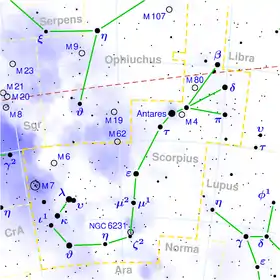AH Scorpii
AH Scorpii (abbreviated to AH Sco) is a red supergiant variable star located in the constellation Scorpius. It is one of the largest stars known by radius and is also one of the most luminous red supergiant stars in the Milky Way.
 | |
| Observation data Epoch J2000 Equinox J2000 | |
|---|---|
| Constellation | Scorpius |
| Right ascension | 17h 11m 17.02114s[1] |
| Declination | −32° 19′ 30.7132″[1] |
| Apparent magnitude (V) | 6.5 - 9.6[2] |
| Characteristics | |
| Spectral type | M4-5 Ia-Iab[3] |
| B−V color index | +2.57[4] |
| Variable type | SRc[3] |
| Astrometry | |
| Radial velocity (Rv) | −13.40 ± 2.4[5] km/s |
| Proper motion (μ) | RA: −4.999±0.433[6] mas/yr Dec.: −2.041±0.282[6] mas/yr |
| Parallax (π) | 1.7338 ± 0.2216[6] mas |
| Distance | 7,400±620 ly (2,260±190[7] pc) |
| Absolute magnitude (MV) | −5.8[8] |
| Details | |
| Mass | 10[7] M☉ |
| Radius | 1,411±124[4] R☉ |
| Luminosity | 330,000+270,000 −150,000[4] L☉ |
| Surface gravity (log g) | −0.5[4] cgs |
| Temperature | 3,450[9] - 3,682[4] K |
| Other designations | |
| Database references | |
| SIMBAD | data |
Distance
The distance of AH Scorpii is considered to be uncertain. VLBI measurements of the masers have provided an accurate distance of 2,260 parsecs based on observation of SiO, H2O, and OH masers in its oxygen-rich circumstellar material. The masers were observed to be approaching the star at 13 km/s, indicating overall contraction at around phase 0.55 of the visual variations.[7] AH Scorpii has a parallax of 1.7338±0.2216 mas in Gaia Data Release 2, implying a luminosity of 13,200 L☉ and radius of 320 R☉ for the star, but that value is considered unreliable due to a very high level of astrometric noise.[6][9] Parallax values from the Hipparcos mission are negative and have relatively large statistical margins of error.[1]
Characteristics
AH Scorpii is a dust-enshrouded red supergiant[10] and is classified as a semiregular variable star with a main period of 714 days. The total visual magnitude range is 6.5 - 9.6.[2] No long secondary periods have been detected.[11] Modelling of AH Scorpii near maximum light has determined an effective temperature of 3,682±190 K and a luminosity of 330,000+270,000
−150,000 L☉. A radius of 1,411±124 R☉ was determined from an angular diameter of 5.81±0.15 mas and the given distance of 2.26±0.19 kpc.[4]
See also
References
- Van Leeuwen, F. (2007). "Validation of the new Hipparcos reduction". Astronomy and Astrophysics. 474 (2): 653–664. arXiv:0708.1752. Bibcode:2007A&A...474..653V. doi:10.1051/0004-6361:20078357. S2CID 18759600.
- Kiss, L. L.; Szabó, Gy. M.; Bedding, T. R. (2006). "Variability in red supergiant stars: Pulsations, long secondary periods and convection noise". Monthly Notices of the Royal Astronomical Society. 372 (4): 1721–1734. arXiv:astro-ph/0608438. Bibcode:2006MNRAS.372.1721K. doi:10.1111/j.1365-2966.2006.10973.x. S2CID 5203133.
- Samus, N. N.; Durlevich, O. V.; et al. (2009). "VizieR Online Data Catalog: General Catalogue of Variable Stars (Samus+ 2007-2013)". VizieR On-line Data Catalog: B/GCVS. Originally Published in: 2009yCat....102025S. 1. Bibcode:2009yCat....102025S.
- Arroyo-Torres, B.; Wittkowski, M.; Marcaide, J. M.; Hauschildt, P. H. (2013). "The atmospheric structure and fundamental parameters of the red supergiants AH Scorpii, UY Scuti, and KW Sagittarii". Astronomy & Astrophysics. 554: A76. arXiv:1305.6179. Bibcode:2013A&A...554A..76A. doi:10.1051/0004-6361/201220920. S2CID 73575062.
- Gontcharov, G. A. (2006). "Pulkovo Compilation of Radial Velocities for 35 495 Hipparcos stars in a common system". Astronomy Letters. 32 (11): 759–771. arXiv:1606.08053. Bibcode:2006AstL...32..759G. doi:10.1134/S1063773706110065. S2CID 119231169.
- Brown, A. G. A.; et al. (Gaia collaboration) (August 2018). "Gaia Data Release 2: Summary of the contents and survey properties". Astronomy & Astrophysics. 616. A1. arXiv:1804.09365. Bibcode:2018A&A...616A...1G. doi:10.1051/0004-6361/201833051. Gaia DR2 record for this source at VizieR.
- Chen, Xi; Shen, Zhi-Qiang (2008). "VLBI Observations of SiO Masers around AH Scorpii". The Astrophysical Journal. 681 (2): 1574–1583. arXiv:0803.1690. Bibcode:2008ApJ...681.1574C. doi:10.1086/588186. S2CID 7603031.
- Baudry, A.; Le Squeren, A. M.; Lepine, J. R. D. (1977). "The supergiant OH stars S Per and AH SCO - Conditions for OH emission in circumstellar envelopes". Astronomy and Astrophysics. 54: 593. Bibcode:1977A&A....54..593B.
- Messineo, M.; Brown, A. G. A. (2019). "A Catalog of Known Galactic K-M Stars of Class I Candidate Red Supergiants in Gaia DR2". The Astronomical Journal. 158 (1): 20. arXiv:1905.03744. Bibcode:2019AJ....158...20M. doi:10.3847/1538-3881/ab1cbd. S2CID 148571616.
- Van Loon, J. Th.; Cioni, M.-R. L.; Zijlstra, A. A.; Loup, C. (2005). "An empirical formula for the mass-loss rates of dust-enshrouded red supergiants and oxygen-rich Asymptotic Giant Branch stars". Astronomy and Astrophysics. 438 (1): 273–289. arXiv:astro-ph/0504379. Bibcode:2005A&A...438..273V. doi:10.1051/0004-6361:20042555. S2CID 16724272.
- Percy, John R.; Sato, Hiromitsu (2009). "Long Secondary Periods in Pulsating Red Supergiant Stars". Journal of the Royal Astronomical Society of Canada. 103 (1): 11. Bibcode:2009JRASC.103...11P.